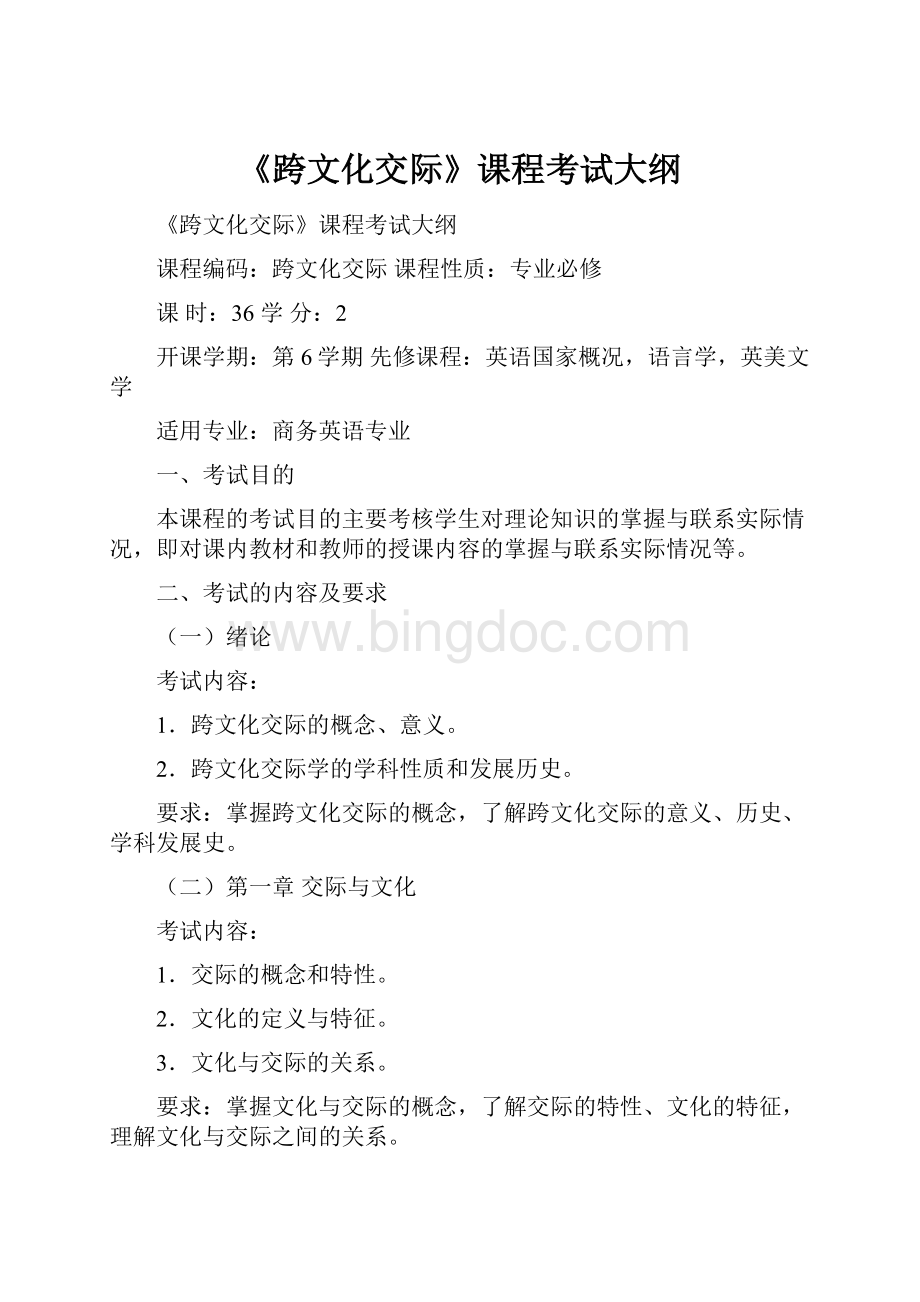《跨文化交际》课程考试大纲.docx
《《跨文化交际》课程考试大纲.docx》由会员分享,可在线阅读,更多相关《《跨文化交际》课程考试大纲.docx(19页珍藏版)》请在冰点文库上搜索。

《跨文化交际》课程考试大纲
《跨文化交际》课程考试大纲
课程编码:
跨文化交际课程性质:
专业必修
课时:
36学分:
2
开课学期:
第6学期先修课程:
英语国家概况,语言学,英美文学
适用专业:
商务英语专业
一、考试目的
本课程的考试目的主要考核学生对理论知识的掌握与联系实际情况,即对课内教材和教师的授课内容的掌握与联系实际情况等。
二、考试的内容及要求
(一)绪论
考试内容:
1.跨文化交际的概念、意义。
2.跨文化交际学的学科性质和发展历史。
要求:
掌握跨文化交际的概念,了解跨文化交际的意义、历史、学科发展史。
(二)第一章交际与文化
考试内容:
1.交际的概念和特性。
2.文化的定义与特征。
3.文化与交际的关系。
要求:
掌握文化与交际的概念,了解交际的特性、文化的特征,理解文化与交际之间的关系。
(三)第二章文化的影响
考试内容:
1.文化的多样性
2.文化的深层结构
要求:
掌握文化模式的概念,了解交际的多样性,理解文化的深层结构。
(四)第三章语言与文化
考试内容:
1.语言与交际的关系,其中包括语音、语义、句法、语用与跨文化交际的关系。
2.语言的翻译。
要求:
通过各种实例、练习了解语音、语义、句法、语用与跨文化交际的关系。
(五)第四章非言语交际
考试内容:
1.非言语交际的概念、功能、特征。
2.非言语的词义和语用。
3.人体语、时间语、空间语。
4.其他非言语信息。
要求:
了解非言语交际的研究概况、功能、特征,了解并学会恰当使用一批常用的非言语,掌握一些常见的不同文化背景下的体态语。
(六)第五章文化对商业语境的影响
考试内容:
1.文化与商业语境
2.国际商业语境
3.国内商业语境
要求:
了解文化价值观对商业语境的影响,并通过与中国传统交易方式的对比,掌握经济全球化形势下如何进行有效沟通,成功进行国际竞争的原则和技巧。
(七)第六章文化对教育语境的影响
考试内容:
1.教育体制差异性
2.多元文化教育背景
3.多元文化背景下的教学方式
要求:
通过学习中外教育体制,了解不同文化中教育理念的差异,以及课堂中师生角色的期待差异所导致的不同课堂风格和教学方法。
(八)第七章文化对保健语境的影响
考试内容:
1.疾病预防及治疗的文化差异性
2.性别文化体现在保健语境中的差异性
要求:
了解不同文化中保健理念的差异,了解性别文化差异性在保健语境中的体现,理解文化差异性可能导致的保健语境中的交际失误。
(九)第八章培养跨文化交际意识
考试内容:
影响跨文化交际的因素
要求:
进一步了解文化的差异性,多元性和发展性。
三、考试方法、考试时间及试题类型
1.考试方法:
笔试
2.计分方式:
3.考试时间:
期末试卷考试时间为120分钟
4.试题类型:
(1)选择题(10%)
(2)判断题(10%)
(3)问答题(20%)
(4)案例分析题(20%)
(5)阅读理解题(20%)
(6)综合写作(20%)
四、教材与主要参考资料
1.教材:
2.主要参考资料:
Samovar,LarryA.CommunicationbetweenCultures.北京:
外语教学与研究出版社.2000
胡超《跨文化交际实用教程》北京:
外语教学与研究出版社,2013
顾曰国《跨文化交际》北京:
外语教学与研究出版社,2009
许力生《跨文化交际英语教程》上海:
外语教育出版社,2008
五、样题
PartOne:
TrueorFalse(15points)
Directions:
ReadthefollowingstatementsanddecidewhethertheyareTrueorFalse.AndwriteTorFontheanswersheet.
1.Incountrieswithhighuncertaintyavoidance,peopletendtoensurecertaintyandsecuritythroughanextensivesetofrulesandregulations.
2.Cultureisastaticentitywhilecommunicationisadynamicprocess.
3.Allculturesrequireandvaluepoliteness,butthewayinwhichpolitenessisachievedmayvarysignificantly.
4.LatinAmerican,African,ArabicandmostAsianculturesareM-Timecultures.
5.Muchofournon-verbalbehavior,likeculture,tendstobeelusive,spontaneousandfrequentlygoesbeyondourawareness.
6.Cultureshocksarealwaysfrustrating,becausetheyalwaysbringnegativeeffectstopeopleinaforeignculture,socultureshocksdonogoodtopeopleininterculturalcommunication.
7.Peopleinpast-orientedculturesrespectoldpeopleandplacehighvalueonhistoryandexperiences.
8.TheJapanesebelievethatsocializingisintegraltothenegotiationprocesswhiletheAmericansdonotthinkso.
9.GermansfindhumoroutofplaceinbusinessmeetingswhileAmericansthinktellingajokewillhelplighttheatmosphere.
10.Encodingistheprocessofperceivingandinterpreting,ormakingsenseofincomingmessagesandstimulifromtheenvironment.
11.Americansenjoytalkingandinterpretsilenceinanegativeway.Theyappreciateapersonwhodominatesaconversation.
12.InUSA,slouchingisconsideredasignofrudenessandpoormanners.
13.LikeJapaneseandChinesenegotiators,adetailedwrittenagreementisnotcentraltothenegotiationprocessintheMiddleEast,FranceandGermany.
14.InChina,friendshipmeansawillingnesstobeindebtedandtorepaythedebtmorethanowed.
15.Cultureissuchacomprehensivetermthatitmayencompasseverything,tangibleorintangible,materialorspiritual.
PartII.Translation(20points)
Directions:
TranslatethefollowingChinesetermsintoEnglishandEnglishtermsintoChinese.
1.stereotypes2.paralanguage
3.ethnocentrism4.masculinity
5.high-contextculture6.monochronictime
7.speechact8.conversationtaboos
9.vocalqualifiers10.powerdistance
11.译码12.偏见
13.文化震惊14.不确定性回避
15.概念意义16.语用错误
17.礼貌原则18.归纳法
19.空间语言20.礼仪与礼节
PartThree:
ReadingComprehension:
(30points)
Directions:
Foreachofthefollowingthreepassages,thereare5questions.Readthepassageandchoosethebestanswerforeachquestion,thanwritethecorrespondingletterontheanswersheet.
Passage1
IntheUnitedStates,youcanfeelfreetovisitinpeople’shomes,sharetheirholidays,enjoytheirchildrenandtheirliveswithoutfeelingobligedtocontinuealifetimerelationship.DonothesitatethereforetoacceptinvitationsfromAmericanssimplybecauseyoucannotinvitethemtoyourhomeinreturn.Noonewillexpectyoutodoso;theyrealizethatyouhavetraveledagreatdistance.Americanswillenjoywelcomingyouandwillbepleasedifyouaccepttheirfriendshipeasily.
VisitorsmaynoticethatalthoughAmericansincludethemeasilyintheirpersonaldailylives,theydonotshowvisitorsagreatamountofspecialcourtesyifdoingsorequiresmuchtime.Thisisfrequentlytheoppositeofwhatoccursinsomecountries,wherepeopleareespeciallygenerousingivingtheirtimetovisitors,butdonotnecessarilywelcomethemasguestsintheirhomes.Insomeplaces,hostswillgotoairportslateatnighttomeetavisitortheydonotevenknowwell;theyspendmuchtimeactingasaguide–allevidenceofgreatgenerosity.Yettheymayneverinvitetheguesttomeettheirfamiliesorjoinintheirfamilylife.Itisimportanttonotethatinbothcasesthefeelingisequallywarmandfriendly;onlythewayofexpressingcourtesiesisdifferent.
Americanswarmlywelcomevisitorsintotheirhomes,andtrytodoasmanyspecialthingsforaguestastimepermits.Ifpossible,theywillmeetyouattheairportbutifnot,youcantakepublictransportationfromtheairporttoyourhotel;andtaxiorbusfromyourhoteltotheirhome.Uponarrival,awarmwelcomewillawaityou.Indeed,visitorsarereadilyinvitedintohomesduringthetimetheyareinthecountry.Althoughitmaybeconsideredmorepropertoentertainaguestatarestaurantinsomecountries,thisisnotthecaseintheUnitedStates.Generally,however,Americansconsideritmorefriendlytoinviteapersontoone’shomethantotakehimtoarestaurant.Forpurelybusinesspurposes,youaremorelikelytobeinvitedtoarestaurant.
Questions1-5arebasedonthepassageyouhavejustread.
1.WhatcanyoufeelfreetodowhenyoustayintheU.S.?
A.Taketheirchildrenoutfordinner
B.Takeyourfamilytoafriend’shome
C.Travelwithyourfriendinholidays
D.Callinafriend’shomeafterwork
2.WhenAmericanswelcomeyou,theydon’tcarewhetheryouwillshowyourcourtesyinreturn.Why?
A.Becausetheyareveryconsiderateandunderstanding.
B.Becausetheyknowyouarenotgoodatshowingthecourtesy.
C.Becausetheyknowyouaretootiredtoreturntheirfriendship.
D.Becausetheyknowyouarenotpleasedwiththeirinvitations.
3.WhichofthefollowingislikelyforanAmericantodo?
A.Accompanytheguesttovisitdifferentplaces.
B.Pickuptheguestlateatnightfromtheairport.
C.Inviteyoutomeettheirfamiliesandhavedinner.
D.Spendmuchtimechattingwithanewfriend
4.Whichofthefollowingistrue?
A.YourAmericanfriendwillsurelymeetyouattheairport.
B.Youcantakethepublictransportationtoyourhotel.
C.Don’texpectAmericanstodospecialthingsforyou.
D.Youwillbeinvitedtostayattheirhomeforthenight.
5.WhichisthecommonwayAmericansusetoentertainaguest?
A.Theywillinviteafriendtoafirst-classrestaurant.
B.Theywillentertainafriendwithhome-madedinner.
C.Theywillinviteabusinesspartnertotheirhomes.
D.TheywilltakethebusinesspartnertoaMacDonald.
Passage2
Linguisticallyspeaking,peoplearenotbornfree.Weinheritalanguage;evenmoreimportantly,weinheritcertainfixedwaysofexpressionthatmayshackleourthoughts.Languagebecomesourshaperofideasratherthansimplyourtoolforreportingideas.
ThewayinwhichcultureaffectslanguagebecomesclearbycomparinghowtheEnglishandHopilanguagesrefertoH2Oinitsliquidstate.English,likemostotherEuropeanlanguages,hasonlyoneword–“water”–anditpaysnoattentiontowhatthesubstanceisusedfororitsquality.TheHopiofArizona,ontheotherhand,usepahetomeanthelargeamountsofwaterpresentinnaturallakesorrivers,andkeyiforthesmallamountsindomesticjugsandcanteens.English,though,makesotherdistinctionsthatHopidoesnot.ThespeakerofEnglishiscarefultodistinguishbetweenalakeandstream,betweenawaterfallandageyer;butpahemakesnodistinctionamonglakes,ponds,rivers,streams,waterfalls,andsprings.
AHopispeaker,ofcourse,knowsthatthereisadifferencebetweenageyer,whichspurtsupward,andawaterfall,whichplungesdownward,eventhoughhisorhervocabularymakesnosuchdistinction.Similarly,aspeakerofEnglishknowsthatacanteenofwaterdiffersfromariverofwater.ButtherealpointofthiscomparisonisthatneithertheHopinortheAmericanusesanywherenearthepossiblenumberofwordsthatcouldbeappliedtowaterinallofitsstates,quantities,forms,andfunctions.Eachculturedefinesthecategoriesintermsofthesimilaritiesitdetects;itchannelsamultitudeofideasintothefewcategoriesthatitconsidersimportant.ThecultureofeveryspeakerofEnglishtellshimorherthatitisimportanttodistinguishbetweenoceans,lakes,rivers,fountains,andwaterfalls–butrelativelyunimportanttomakethedistinctionbetweenthewaterinacanteeninhisorhercanoeandthewaterunderneaththesamecanoe.Eachculturehascategorizedexperiencethroughlanguageinaquiteunconsciousway.
ThepossibilityofsucharelationshipbetweenlanguageandculturehasbeenformulatedintoahypothesisbytwoAmericanlinguists,SapirandWhorf.Accordingtothem,wedonotliveinthemidstofthewholeworld,butonlyinapartofit,thepartthatourlanguageletsus